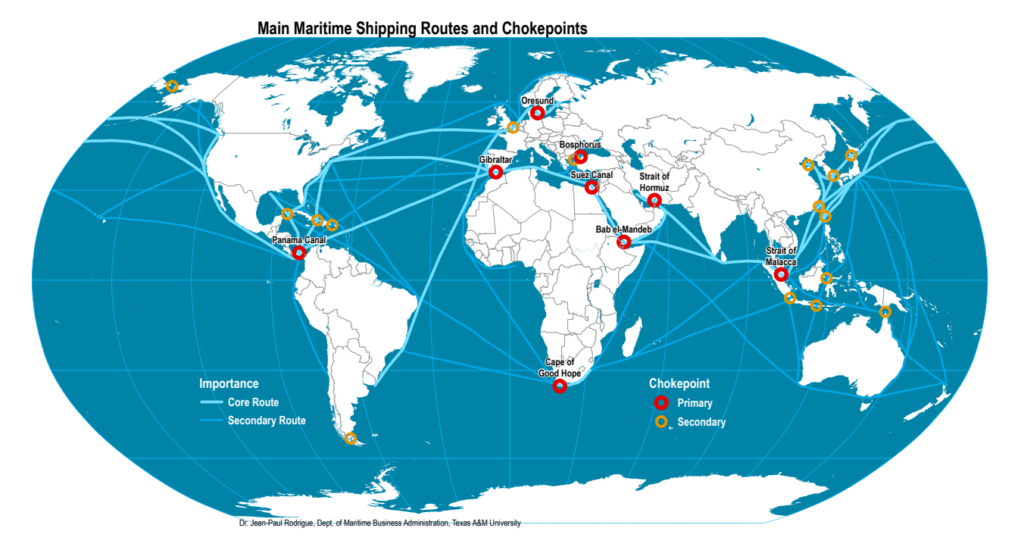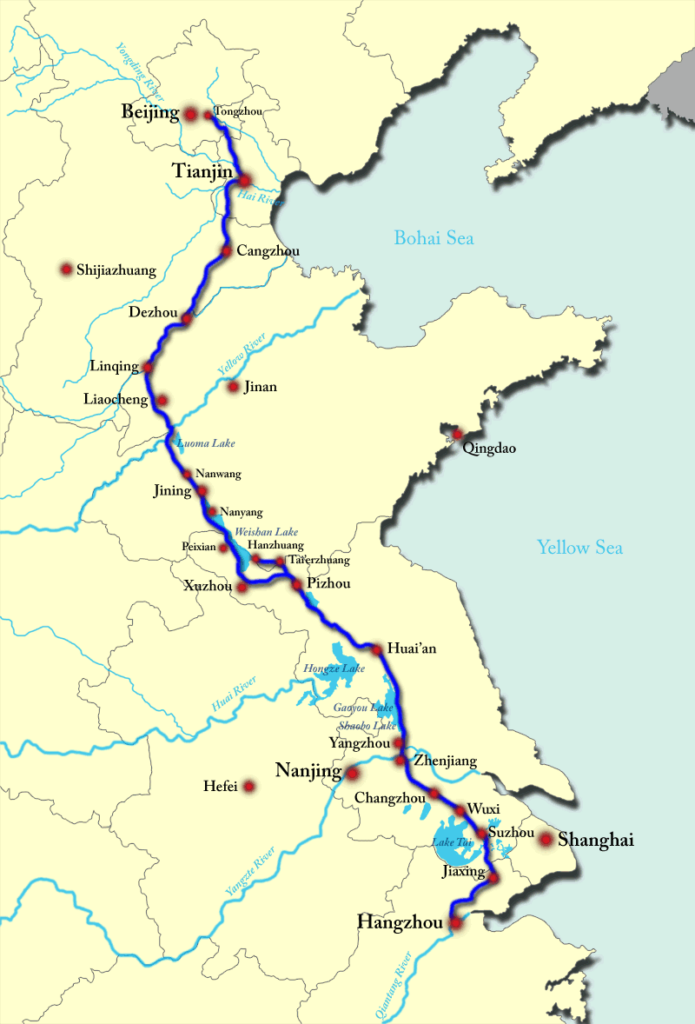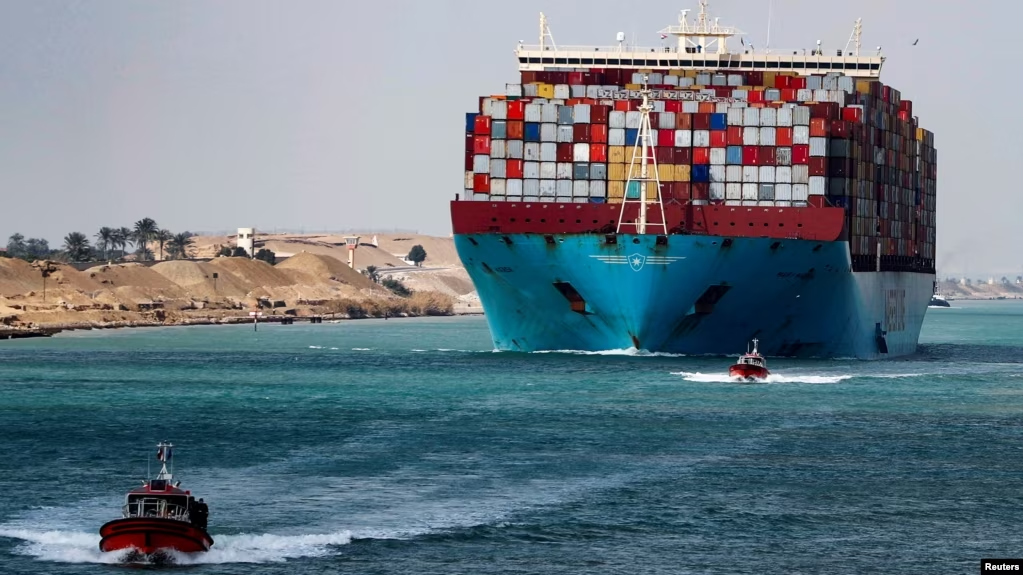Introduction
Global trade depends heavily on maritime transportation, with over 80% of the world's goods moving by sea. Some waterways serve as critical chokepoints, ensuring efficient and cost-effective transportation between continents. These waterways not only shorten routes but also enable the movement of energy resources, raw materials, and consumer goods. This article explores the world's most essential waterways and their strategic importance.

1. Panama Canal (Central America)
Strategic Importance:
The Panama Canal, spanning 82 km (51 miles), connects the Atlantic and Pacific Oceans, significantly reducing travel time for ships that would otherwise have to navigate around South America’s Cape Horn.
Key Facts:
Handles about 5% of global maritime trade.
Saves ships approximately 8,000 nautical miles compared to the route around South America.
Major users include the United States, China, and Japan.
Challenges:
Water shortages due to climate change have led to restrictions on vessel size and capacity.
The Panama Canal has faced significant operational challenges due to water shortages, particularly during drought periods. In late 2023, a severe drought led to a substantial reduction in daily vessel transits. The Panama Canal Authority (ACP) decreased the number of crossings to 24 per day, down from the typical 34 to 36 daily transits, to conserve water resources.
This reduction in transit capacity resulted in considerable delays, with ships experiencing extended waiting times to cross the canal. The backlog led some vessels to opt for alternative, longer routes, such as navigating around the Cape of Good Hope, to avoid the congestion.
The water shortages were primarily due to lower-than-average rainfall, which caused water levels in critical reservoirs like Gatun Lake and Lake Alajuela to drop significantly. These lakes are essential for canal operations, as they provide the freshwater necessary for the lock systems.
In response to improving water conditions, the ACP increased daily transits to 27 ships per day in March 2024. However, the canal continued to face challenges, including higher tolls, which led some shippers to consider alternative routes to Asia.
These operational adjustments underscore the canal's vulnerability to climatic variations and the importance of sustainable water management practices to ensure its continued functionality.
High toll costs make alternative routes like the Suez Canal more attractive in some cases.
2. Suez Canal (Egypt)
Strategic Importance:
The 193 km (120-mile) Suez Canal is the fastest maritime route between Europe and Asia, bypassing the long and hazardous journey around Africa’s Cape of Good Hope.
Key Facts:
Carries about 12-15% of global trade.
Major passage for oil, liquefied natural gas (LNG), and containerized goods.
Main users include Europe, China, and the Middle East.
Challenges:
Vulnerable to blockages, as seen in the Ever Given incident in 2021, which disrupted global supply chains.
Increasing transit fees by the Suez Canal Authority (SCA).
3. Strait of Hormuz (Middle East)
Strategic Importance:
The Strait of Hormuz is the most critical chokepoint for global energy security, connecting the Persian Gulf to the Arabian Sea. It serves as a vital route for oil exports from the Gulf nations.
Key Facts:
About 20% of the world’s oil supply passes through the strait.
Primary exporters include Saudi Arabia, Iran, the UAE, and Iraq.
Key importers are China, India, Japan, and South Korea.
Challenges:
Geopolitical tensions, including Iranian naval threats and military conflicts.
Vulnerable to blockades and attacks on oil tankers.
4. Strait of Malacca (Southeast Asia)
Strategic Importance:
The Strait of Malacca, located between Malaysia, Indonesia, and Singapore, is the primary maritime link between the Indian Ocean and the Pacific Ocean.
Key Facts:
Handles about 25% of global trade.
Major route for China, Japan, South Korea, and India.
A key passage for oil, coal, and containerized goods.
Challenges:
Prone to piracy, particularly in the waters off Indonesia.
Congestion and environmental concerns due to high traffic volumes.
5. Bab el-Mandeb Strait (Red Sea – Gulf of Aden)
Strategic Importance:
The Bab el-Mandeb Strait connects the Red Sea to the Gulf of Aden, making it a crucial gateway for trade between Europe, Asia, and the Middle East.
Key Facts:
About 9% of global trade flows through this strait.
Essential for Suez Canal-bound traffic, especially oil shipments from the Middle East.
Major players include Saudi Arabia, the UAE, and European nations.
Challenges:
Vulnerable to Houthi rebel attacks and regional conflicts.
Security risks due to piracy in the Gulf of Aden.
6. Bosporus & Dardanelles (Turkey)
Strategic Importance:
These narrow straits connect the Black Sea to the Mediterranean, enabling trade between Russia, Ukraine, and the global market.
Key Facts:
Critical for grain exports from Ukraine and Russia.
Major route for Russian oil and natural gas shipments to Europe.
Controlled by Turkey under the Montreux Convention.
Challenges:
Geopolitical tensions, particularly following the Russia-Ukraine war.
Environmental risks from oil spills and shipping accidents.
7. The English Channel (Europe)
Strategic Importance:
The English Channel, separating the UK and France, is the busiest shipping lane in the world. It serves as a key trade route between the UK, Europe, and the rest of the world.
Key Facts:
Over 500 ships transit daily.
Key hub for container ships, oil tankers, and ferries.
Essential for post-Brexit trade between the UK and the EU.
Challenges:
Traffic congestion and strict maritime regulations.
Weather conditions can impact navigation.
8. The Danish Straits (Denmark – Baltic Sea)
Strategic Importance:
The Danish Straits provide a vital maritime link between the Baltic Sea and the North Sea, serving as a major export route for Russia and Northern European countries.
Key Facts:
Essential for Russian oil and gas shipments to Europe.
Handles a significant share of Nordic and Baltic trade.
A key route for Germany, Sweden, and Poland.
Challenges:
Growing NATO-Russia tensions.
Potential disruptions from ice conditions in winter.
9. Beijing-Hangzhou Grand Canal

The Grand Canal is the world’s longest artificial waterway and a UNESCO World Heritage Site. It links five of China’s major river basins. The Beijing–Hangzhou Grand Canal is 1776 km long and runs from Beijing to Zhejiang. It was built in sections from the 5th century BC to unify the communication networks for the first time in the 7th century AD.
It led to the emergence of huge construction sites, forming the world’s most extensive civil engineering program before the Industrial Revolution. It was used for shipping grain, and raw materials and supplying rice to the people, making it vital for the sustenance of the Empire as it is for China even today.
